Milk Bread Doughnuts with Yuzu Cream
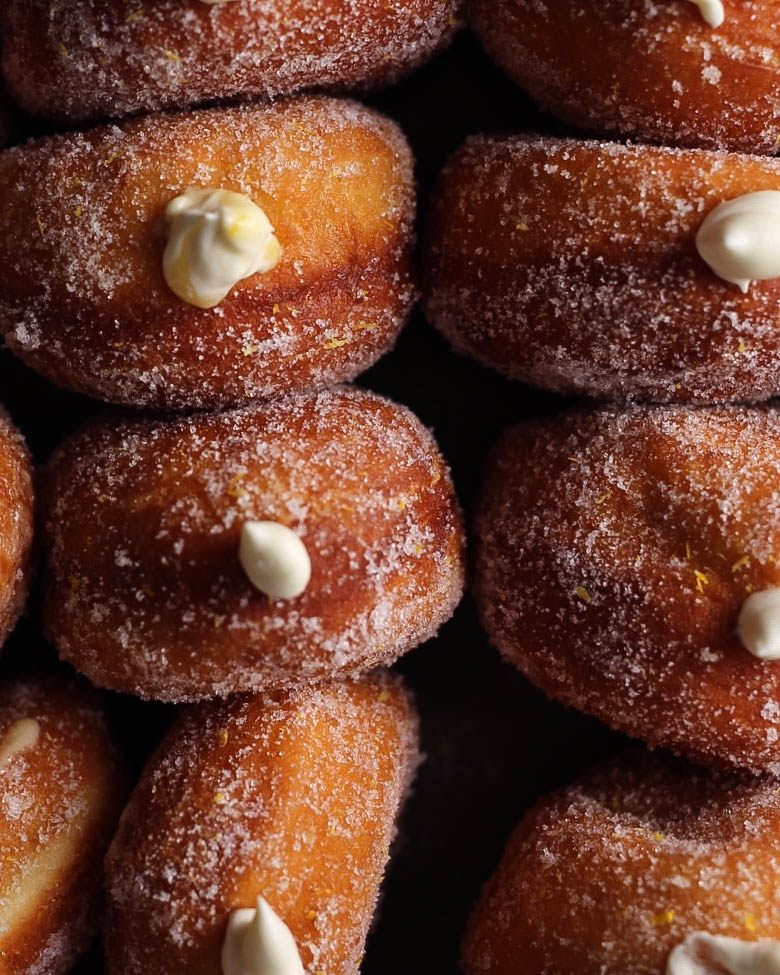
Confession: I had the vision for these doughnuts before I had ever made a loaf of milk bread. However, once I finally got around to trying the recipe in Cynthia Chen McTernan’s wonderful cookbook, A Common Table, it confirmed my instinct that the dough had doughnut promise. McTernan’s milk bread recipe produces a fluffy, pillowy loaf that gets its wonderful texture from a sort of roux called tangzhong. It’s an enriched dough bread, but not as rich as, say, a brioche.
Would the dough’s pillowy texture translate in a doughnut? The answer is yes.
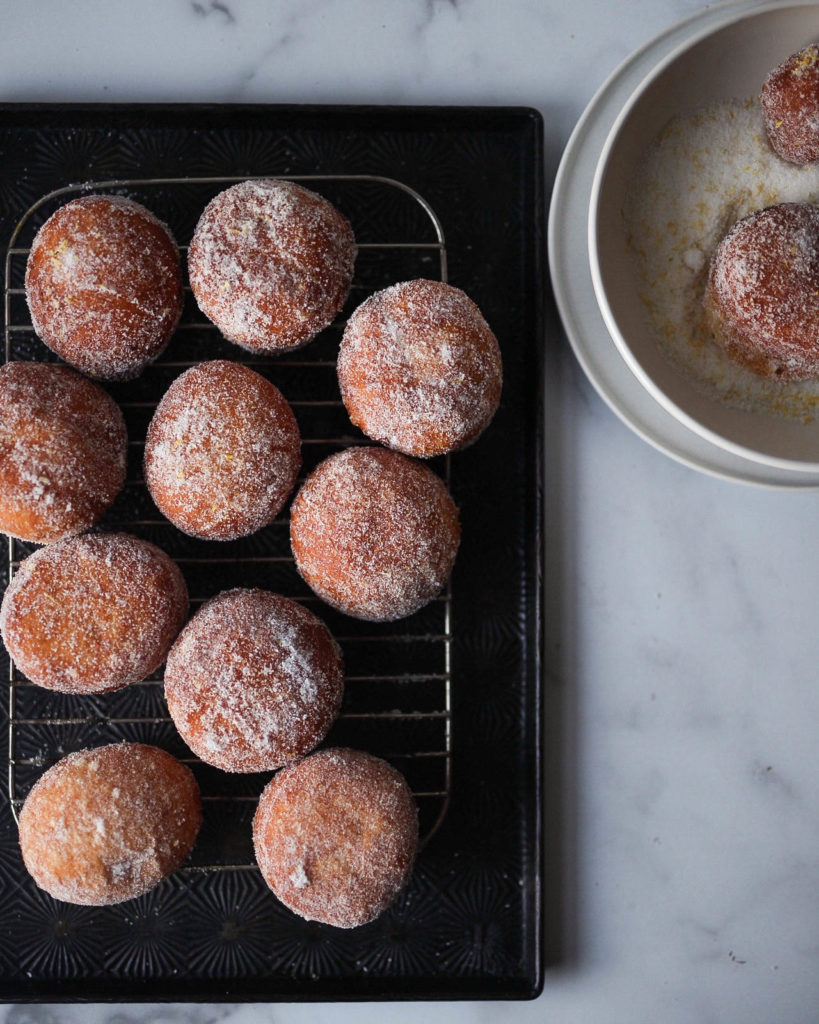
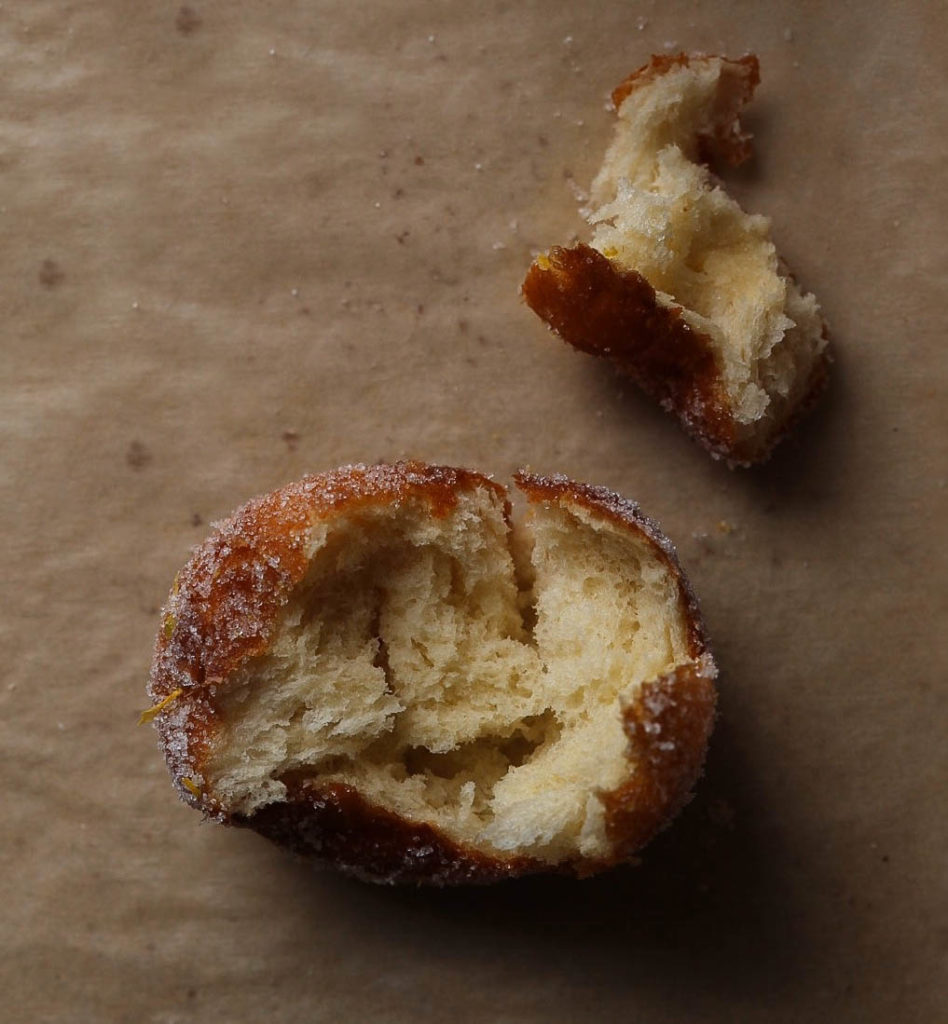
The doughnut recipe below incorporates a few tips and tricks I’ve learned from others: The trick of transferring the doughnuts to the hot oil on squares of parchment comes from Sweet, by Yotam Ottolenghi and Helen Goh. The tip of keeping the oil at around 365 F comes from Zoe Francois in Holiday and Celebration Bread in Five Minutes a Day. Once the doughnuts are cut out and have gone through their last rise, the cooking goes very quickly. It’s possible to make these on a weekday morning, though they’re probably best enjoyed as a treat during a leisurely weekend breakfast.
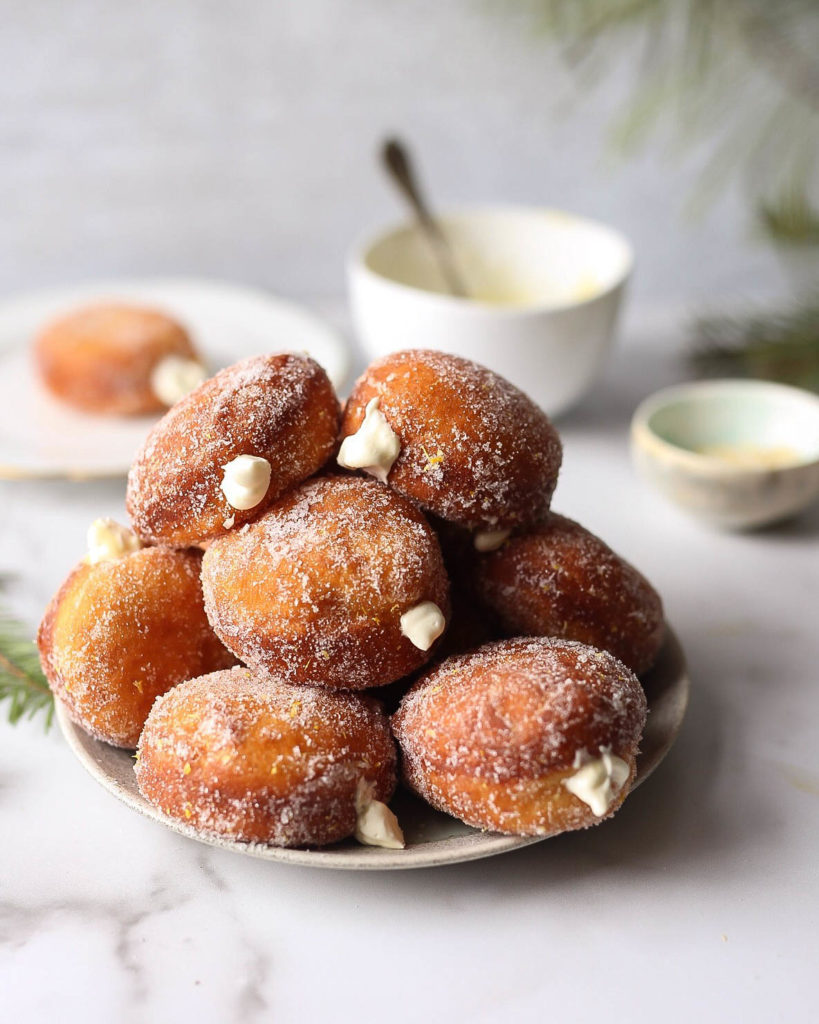
When I imagined these doughnuts, I also had a vision for a filling — something creamy and not too sweet. Since Hokkaido milk bread originated in Japan, my mind turned to yuzu, a Japanese citrus with a lovely, delicate flavor. One problem: I’d never actually seen fresh yuzu at any market. Bottled yuzu juice, though, is not too hard to find, and, as the idea for these doughnuts percolated, I purchased some on Amazon. It sat in my fridge for some time, as I continued to contemplate, but not actually make, the envisioned Hokkaido milk bread doughnuts.
The impetus to actually attempt these doughnuts came when I was in Austin, Texas, visiting my parents, and made a trip to the wonderful Central Market to buy some Texas oranges. There they were, in the citrus section, right in front of me: fresh yuzu. I bought half a dozen. Then, I went about creating the envisioned creamy filling. This proved more difficult than I imagined. I started with a yuzu curd, swirled with whipped cream. Delicious, but messy: the creamy filling, though, thick, tended to drizzle out of the filled doughnuts (in a sort of charming manner, but still, not what I envisioned).
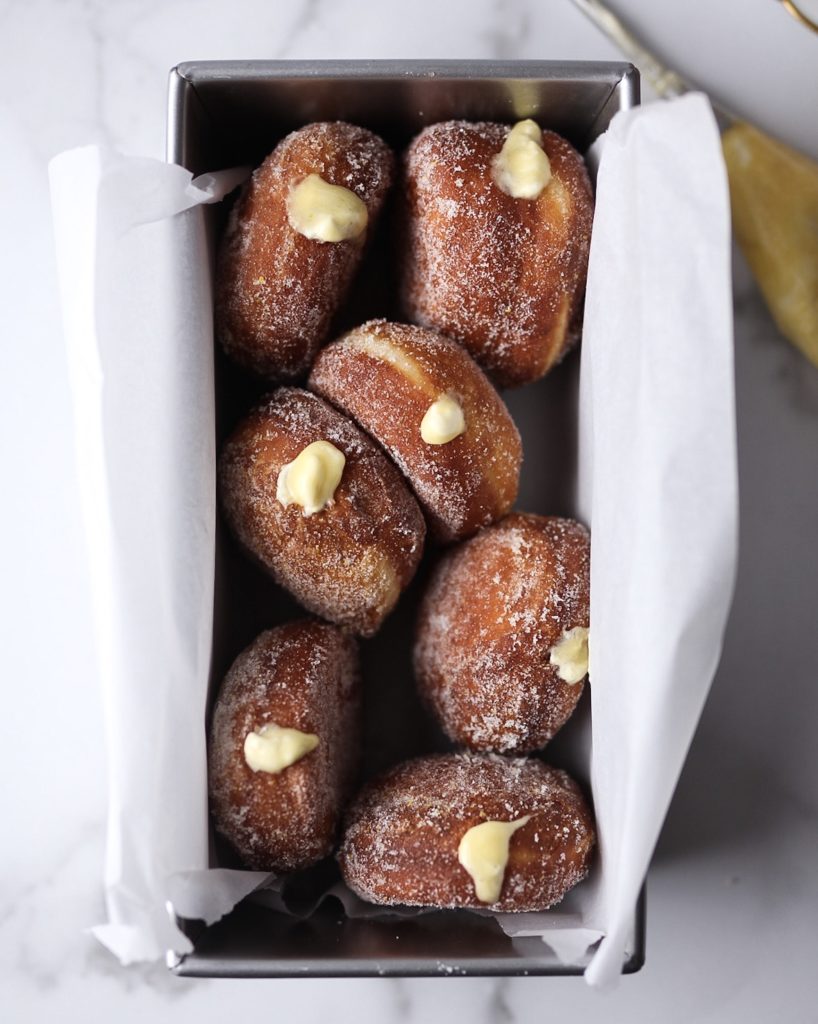
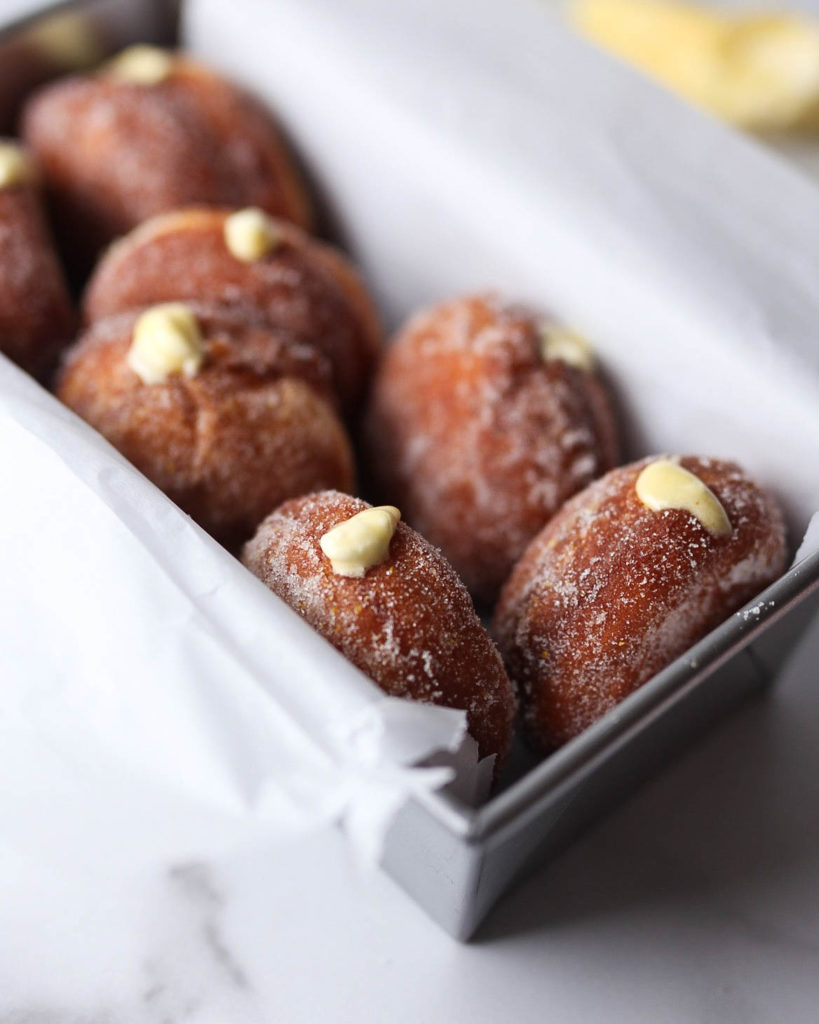
Two more attempts, with different curd recipes, did not solve this problem, except when I dramatically increased the whipped cream:curd ratio. That approach, however, muted the citrus too much for my taste. The issue, I realized, was the stability (or lack thereof) of the yuzu curd. I wondered whether adding a bit of cornstarch, in the manner of a pastry cream, might help. Then, fortuitously, I came across exactly the recipe I was looking for in the Washington Post — a Meyer lemon pastry cream doughnut filling. The yuzu pastry cream below is based on that recipe.

Milk Bread Doughnuts with Yuzu Cream
A fluffy, pillowy doughnut, made with milk bread dough adapted from Cynthia Chen McTernan's recipe in A Common Table.
Ingredients
- 1/2 cup whole milk
- 1 large egg
- 1 1/2 tsp instant yeast (see notes for active dry yeast alternative)
- 2 tbsp sugar
- 1/2 tsp sal
- 1 tbsp nonfat dry milk powder
- 320 g bread flour (plus up to 2 tbsp / 15 g extra – see notes)
- 2 tbsp unsalted butter (very soft)
For the tangzhong:
- 6 tbsp water
- 2 tbsp (15 g) bread flour
For frying the doughnuts:
- canola or other neutral frying oil
Filling:
- 1/4 cup heavy cream
- 1/2 cup yuzu pastry cream (recipe follows) or 2-4 tbsp citrus curd (see Notes)
Coating:
- 1/2 cup sugar or yuzu sugar (recipe follows)
Instructions
-
Scald the milk, either in a small saucepan on the stovetop, or by microwaving it for 1 minute. Set aside to cool. (If a skin forms, just carefully remove it with a fork or teaspoon.)
-
Make the tangzhong: In a small saucepan, whisk together the 6 tablespoons water and 2 tablespoons bread flour until smooth. Cook over medium-low heat, whisking constantly, until the tangzhong thickens and the whisk leaves a line as you mix. Remove from the heat, transfer to a small bowl, and set aside to cool to warm room temperature (90-95 F is fine).
-
In the bowl of a stand mixer, whisk together 320 g bread flour, the yeast, sugar, dry milk, and salt.
-
In a separate bowl, whisk together the milk, cooled tangzhong, and egg.
-
Make a well in the center of the dry ingredients, pour in the milk mixture, and mix with a wooden spoon or silicone spatula until a shaggy dough forms. Transfer to the stand mixer, fitted with a dough hook, and knead at the lowest setting until the dough is fairly smooth. This should take less than 5 minutes.
-
Add the butter, one tablespoon at a time, waiting until the first tablespoon is fully incorporated before adding the second.
-
Continue to knead with the stand mixer on low until the dough is smooth, stretchy, and passes the windowpane test. (If the dough seems excessively sticky during this kneading, add up to 2 tablespoons more flour, just a little bit at a time. With the stand mixer, I generally don't need to add any extra flour at all.)
-
Transfer the dough to a clean bowl (no need to grease), cover with plastic wrap, and refrigerate for at least 8 hours or overnight.
-
The next morning, prepare the doughnuts for frying. First, cut a dozen 2.5 inch squares of baking parchment and place on a large baking sheet.
-
Next, remove the dough from the refrigerator and turn it out onto a lightly floured surface. Roll the dough out to a thickness of a scant 1/2 inch. Cut out the doughnuts using a lightly floured, 2.5 inch biscuit cutter, re-rolling the scraps as necessary. Place each doughnut on one of the pre-cut squares of parchment, on the baking sheet. When all the doughnuts have been cut out, cover the baking sheet with plastic wrap, and allow the doughnuts to rise at room temperature for 1 hour.
-
About 20 minutes before the doughnuts are done rising, heat 2 to 3 inches of neutral oil (such as canola) in a large, heavy-bottomed pan or dutch oven, over medium-high heat. Position a candy thermoteter or deep fry thermoteter in the pan to keep track of the temperature–you're going for 365 F. When the oil reaches 365 F, turn down the heat to medium.
-
Place a wire rack over a large baking sheet, and set it somewhere in close proximity to the stove–this is where you'll transfer the doughnuts after they're fried. Then take a second wire rack and place it over a second baking sheet–this is where you'll place the doughnuts after they have been coated in sugar.
-
You'll fry the doughnuts in batches, 2 to 3 at a time. Transfer the doughnuts to the hot oil on their parchment squares — you'll place the parchment right in the oil, where it will dislodge from the doughnut. Use heatproof tongs to fish out the parchment, then fry the doughnuts for about 1 minute to 1 minute and 15 seconds on each side (2 to 2.5 minutes total), until golden brown and with an internal temperature of between 195 and 200 F. To get the timing right, err on the shorter side for the first doughnut, check it with an instant read thermometer, and adjust as necessary with the remaining doughnuts.
-
As you fry the doughnuts, keep a watch on the temperature of the oil as well–it's okay if the temp rises a little, but you don't want it to go above 375. If the oil temp start to creep up too high (or fall too low), adjust the heat as necessary.
-
Remove the doughnuts from the hot oil using a spider or slotted spoon and transfer them to the wire rack.
-
While the doughnuts are still slightly warm, coat them in the sugar or yuzu sugar, and transfer them to the clean wire rack. Allow the doughnuts to cool completely.
-
Prepare the yuzu cream: In a chilled bowl, whip the heavy cream until stiff peaks form. Gently fold the whipped cream into the yuzu pastry cream or curd.
-
Transfer the yuzu cream to a pastry bag fitted with a bismarck tip, and fill the doughnuts. Serve as soon as possible! (The doughnuts should be fine for an hour or two, but will be best when freshest.)
Recipe Notes
- For this recipe, I used SAF Gold instant yeast, which is specially formulated for enriched doughs. However, you could also you active dry yeast. If you go that route, allow the scalded milk to cool to 110 F, then add the active dry yeast to the milk and allow it to sit for 5-10 minutes until foamy. Then add the tangzhong and egg to the yeast-milk mixture.
- In the original recipe, McTernan specifies up to 1/4 cup (30 g) extra flour, but I’ve found, when using the stand mixer, than little or no additional flour is needed. I’ve specified up to 2 tablespoons additional flour here, but only add it if the dough seems sticky after a few minutes of kneading.
- In the picture above, the doughnuts are filled with a yuzu cream made by folding whipped cream into yuzu curd. The yuzu pastry cream below produces a somewhat thicker, more stable filling, but either option is delicious. And if you can’t find yuzu, feel free to substitute Meyer lemon or regular lemon in the curd, pastry cream, and/or sugar coating.
- For an even sharper citrus hit, use the full amount of the yuzu pastry cream in the recipe below, and reduce or eliminate the whipped cream.
Yuzu Pastry Cream
Adapted from The Washington Post.
Ingredients
- 1/3 cup yuzu juice
- 1 tsp finely grated yuzu zest (optional)
- 60 g (scant 1/3 cup) granulated sugar
- 2 large egg yolks at room temperature
- 1 tbsp cornstarch
- 3 tbsp unsalted butter at room temperature, cut into 6 pieces
Instructions
-
In a medium bowl, whisk together the sugar, optional yuzu zest, egg yolks, and cornstarch until smooth.
-
In a small saucepan, heat the yuzu juice on medium to medium-high heat until simmering. Turn the heat down to medium low.
-
Very slowly whisk the heated yuzu juice into the egg mixture to temper it. Pour the mixture back into the saucepan, place on the stove over medium low heat, and cook, whisking constantly, until mixture thickens and becomes pudding-like. This should only take 5 minutes or so.
-
If you used the optional zest, pour the cooked pastry cream through a fine sieve into a medium bowl. (If you don't care about bits of zest in the cream, or didn't use the zest, you can skip the sieve.) Whisk in the butter, one piece at a time, waiting until each piece is fully incorporated before adding the next one. The mixture should be very smooth and shiny. Cover the pastry cream with plastic wrap, placing the wrap directly on the surface to keep a skin from forming. Refrigerate for at least 4 hours, or overnight.
Yuzu Sugar
Ingredients
- t tsp fine yuzu zest
- 1/2 cup granulated sugar
Instructions
-
In a small bowl, rub the yuzu zest into the sugar. Cover with plastic wrap and refrigerate overnight. Optional: In the morning, transfer the mixture to a food processer and pulse a few times, until the zest is even more finely grated and distributed in the sugar.
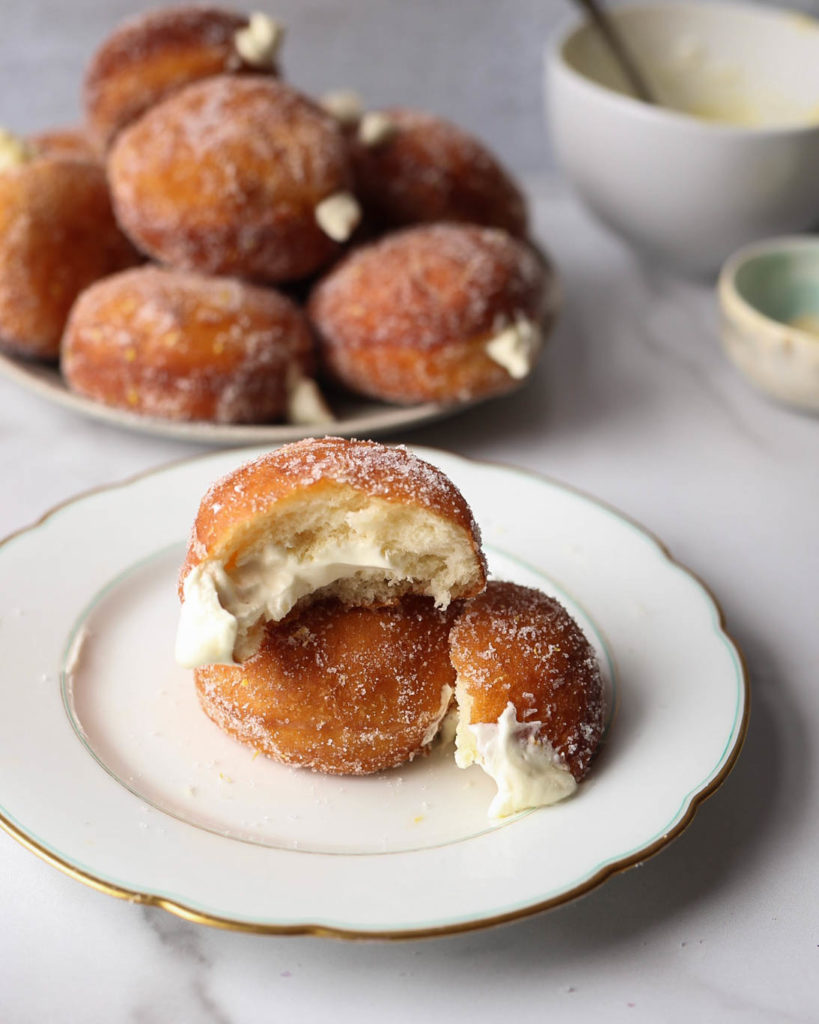
Just wondering if this recipe could be adapted to baking the donuts rather than frying? let’s say, putting the balls of dough in muffin tins?
They wouldn’t be doughnuts then! Just milk bread rolls.
Ok, but you could bake them and then fill them, right ? Then it would be a baked , filled donut.
Not really, no. It would be a cream-filled roll, something akin to what in Japanese bakeries is called “cream pan.” You also probably will not be able to get the sugar coating to adhere if the dough is not fried. I love cream pan, and it’s a great alternative to a filled doughnut when you want something a bit lighter but still sweet and yeasty. But I would not call it a doughnut!
Hi! Would the frying time be the same if I put the donuts in an air fryer? Thanks!
I’ve never used an air fryer, so I have no idea, unfortunately!
I’ve made these twice now and I think this is my favorite donut of all time. The texture is incredible and they’ve been a huge hit when I’ve brought them to birthdays. Thank you!
I am so happy to hear that!
hi! your recipe sounds great but what if I don’t have a refrigerator and how long do I need to rest the dough at room temperature
At room temperature it will depend on the temp of your room and the activeness of your starter/discard. Sorry I can’t be more specific!